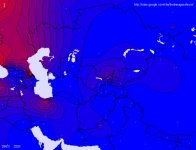Cobol19, saying that the frequency of I2a-Din in the Balkans is evidence that it originated there is poor reasoning. The center of diversity of I2a-Din is apparently not in the Balkans, and the clade TMCRA is very young to begin with, indicating that it expanded on the Balkans rapidly and recently (relatively speaking, the Classical and Medieval periods are very much in play). As I've mentioned, Nordtvedt places the center of diversity of I2a-Din north of the Balkans, as diversity of it appears to increase as we go north. However, it's less clear where the center of diversity is on an east/west scale, mainly because we don't have enough data on I2a-Din in the East.
That isn't to say that I agree with Bodin, especially on his dismissal of the Slavs as being the source of I2a-Din in the Balkans. His main objection to that theory seems to be that the Slavs carried primarily R1a, which is now more rare than I2a-Din in the Balkans. But I think this frequency-based argument runs into similar issues. It's entirely possible that the expanding population had genetic drift toward a minority haplogroup, or that they were such a small segment of the original population that their haplogroup frequencies weren't representative of the whole. Besides, there is significant North Slavic I2a-Din, which we are fairly sure is older than Balkan I2a-Din, so why not assume them as the source, given that our knowledge of Eastern I2a-Din is lacking?
To rephrase what I said, when I think of the Balkans I tend to mix it up with Southeast Europe, the latter is where I think the diversity is highest, I never said frequency is more relevant than diversity, nor do I have to say that since it was not what I was arguing with Bodin, the initial claim he made was that I2a2 existed among the Medes, I have no idea where he came up with this, but when I mentioned the Balkans, my main arguments were:
a) I2a2 in West Asia is mostly a gene wave from the Balkans to Anatolia (This point did not mean it originated in the Balkans).
b) It's highly unlikely that it existed among the Medes since the Iranic people came to West Asia from South-Central Asia where haplogroup I* and its subclades are seriously lacking, and if it did exist among the Medes in West Asia, it surely did not exist among their Iranic ancestors in their ancestral lands.
c) We don't have enough evidence that most I* in West Asia are I2a2 nor do we have enough evidence of the percentages (The argument was about the Kurds), I say this because other subclades actually exist in the region (Like I2c for example), so for all we know, it may be a mixture of I's (I2a, I2b, I2c, along with a few I1's), until further studies are done on these subclades, there's no need to rename the I* to I2a2 just because someone feels it, after all this is not about feelings, it's about evidence, and Bodin was not providing that evidence.


